Roasted butternut squash mash is delicious and silky smooth, makes a great alternative to mashed potatoes, and this easy recipe will soon become your new favourite side dish!
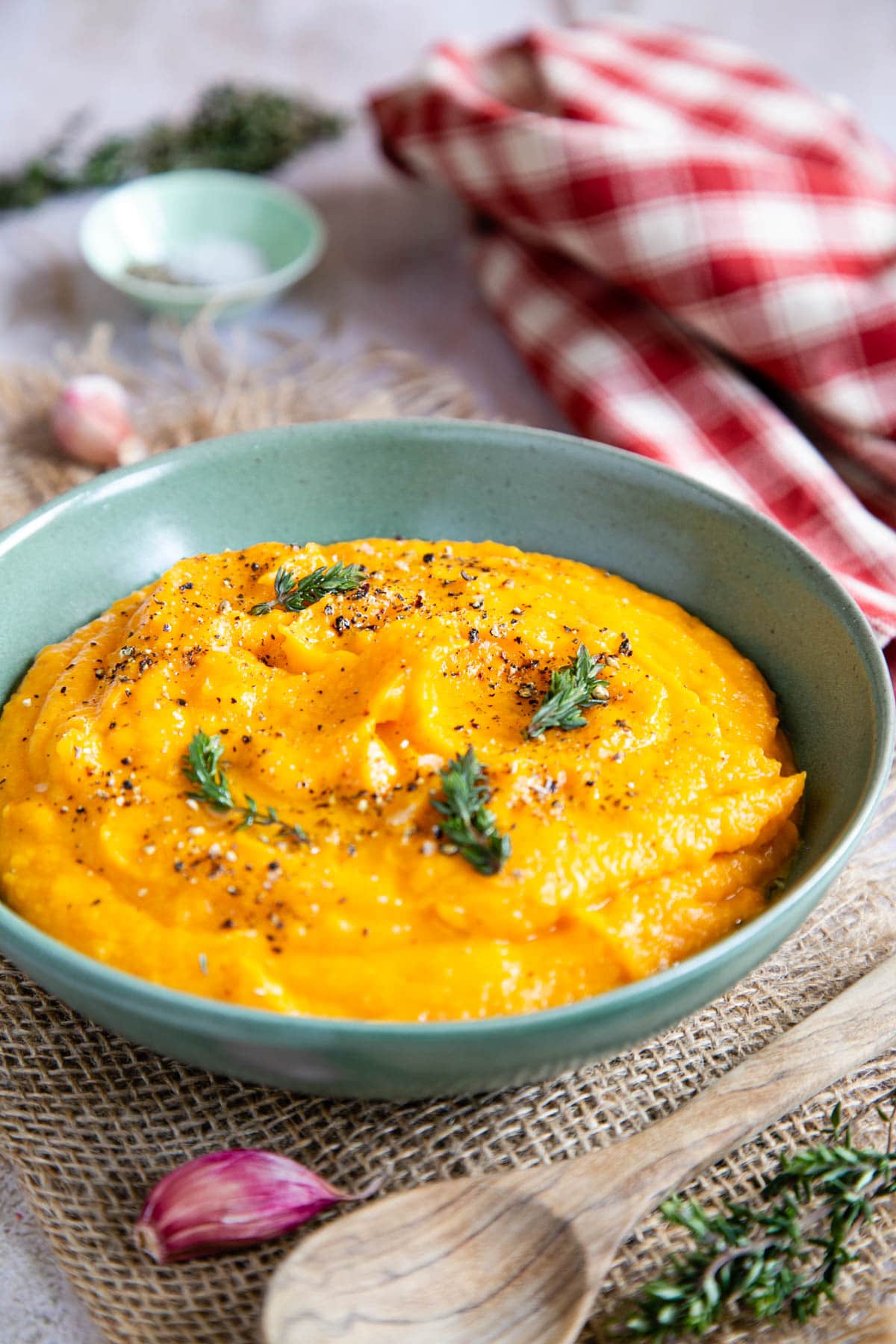
Butternut squash mash
This beautiful golden mash made with roasted butternut squash will become your new favourite side. It is both sweet and savoury, and can be flavoured any way you like.
I like mine with butter, herbs, garlic and some parmesan, but there are lots of delicious alternatives and you could easily spice it up.
This recipe for butternut squash mash is easy to make, with very little prep. There’s no peeling, and just one chop, when you cut the squash in half.
Squash keep so well that they are readily available all year round, so there is no need to wait for autumn to enjoy this light and flavoursome alternative to potato mash. Nevertheless, our thoughts turn to them at harvest time, and that glorious autumnal colour is feast for the eyes too.
Read on and I’ll show you how to prepare and make a perfect fuss free butternut squash mash every time.
Butternut squash nutrition
Unlike potatoes, butternut squash counts as one of your five a day (or seven a day, or more). Squash are a nutritional powerhouse, full of vitamin C and beta-carotene for vitamin A, as well as essential minerals and plenty of fibre.
Nutrient dense, but low in calories, they are one of my favourite vegetables. Full of flavour, beautiful to look at and downright good for you, they make a great addition to so many recipe.
Because they are lighter and less starchy than potatoes, I don’t need to feel guilty about adding butter and cheese to squash. In fact, you need a little fat to make the most of that great butternut squash nutrition, because it is needed to convert the beta-carotene to vitamin A.
Butternut squash vs potatoes
You can use butternut squash in much the same way that you would use potatoes: boiled, roasted, as fries or mash. It is readily available, keeps well and while it used to be quite expensive in the UK, it is generally very affordable now. It is also delicious and easy to prepare.
Winter squash, however, is much moister that potatoes. This means you can’t do a straight swap in recipes. If you do, the dish can be watery and disappointing.
Unlike potato, you can blend or process squash to mash perfection without making a gloopy sticky mess. Instead, you can create silky-smooth and sumptuous mash with very little effort.
Butternut squash mash is always going to be softer and looser than a potato mash. This does not mean, however, that it has to be runny and wet.
The simple solution to the wateriness of butternut squash is to roast it. I am a huge fan of roasted butternut squash. Roasting draws out water and concentrates the flavours, giving you a great addition to all sorts of dishes.
Why make mashed butternut squash
- It is gorgeous – full of flavour, silky texture and beautiful to look at.
- Roasted butternut mash is a great alternative to potato mash.
- Butternut squash is superior to potatoes in nutrition and counts towards your 5 a day.
- Unlike potato mash, you can mash this with a blender, mixer or processor – no more physical mashing!
Butternut squash mash ingredients
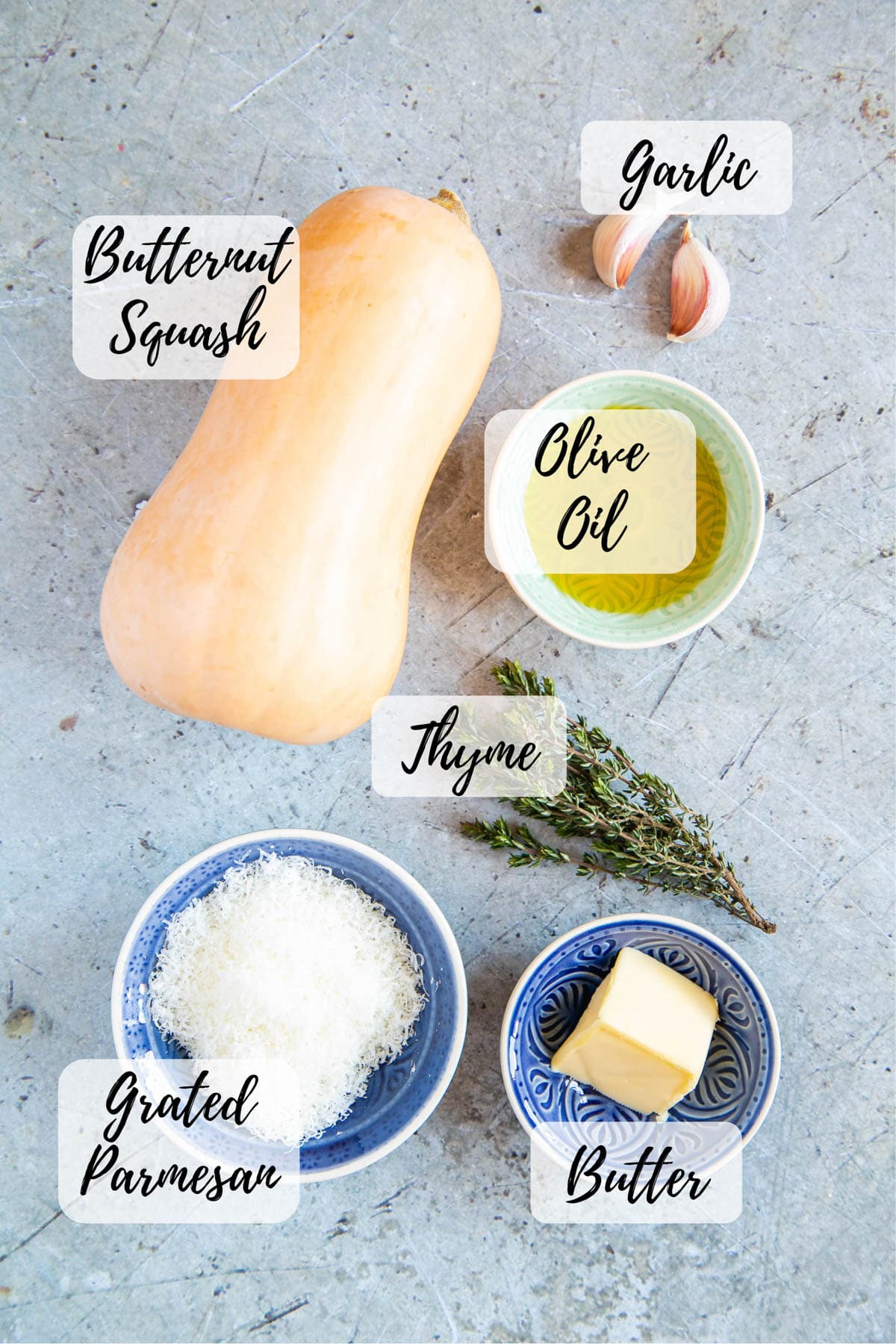
- Butternut Squash – I usually use a roasting butternut squash, as these have a wider neck and a smaller seed cavity. If you are buying by item, rather than weight, you will get more for your money.
- Olive Oil – I like a nice, well-flavoured extra virgin oil.
- Garlic – Optional, but delicious. We roast it with the squash, making it sweeter and less pungent.
- Herbs – You need a woody herb in this mashed butternut squash recipe. I’ve used thyme, but sage, rosemary, oregano or even a few bay leaves would work well here.
- Butter – For both texture and flavour
- Parmesan – or any other strong, hard cheese, finely grated. If you prefer a vegetarian alternative, go for it!
How to make roasted butternut squash – step by step
Before you start, read my step-by-step instructions, with photos, hints and tips so you can to make this mashed butternut squash recipe perfectly every time.
Scroll down for the recipe card with quantities and more tips at the bottom of the page.
First, preheat the oven on to 200°C / 400°F / Gas Mark 6.
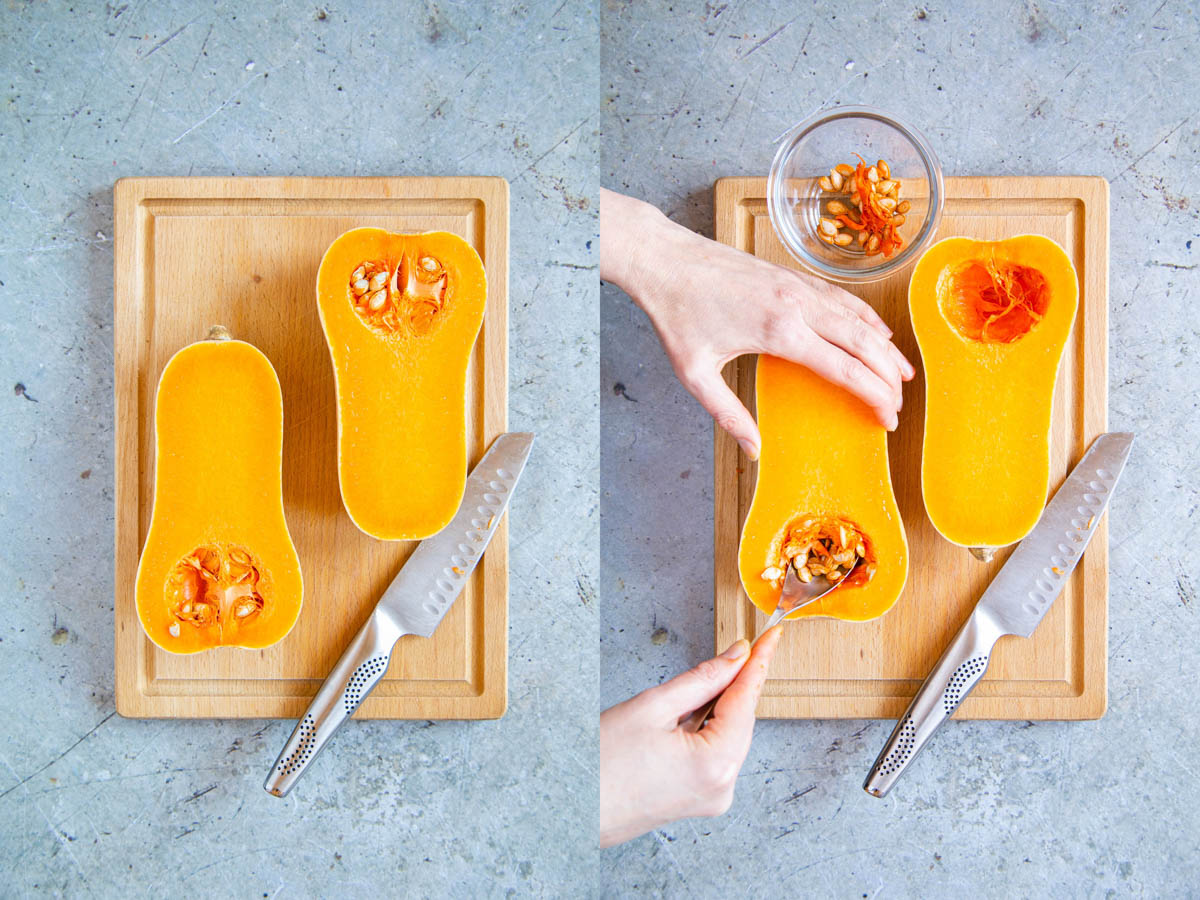
Step One – Cut the squash in half lengthwise and scoop the seeds out with a spoon.
Helen’s Fuss Free Tip
It helps to have a sturdy chopping board and a good, heavy, sharp knife. If necessary, fold up a tea towel and use that to press down on the back of the knife to make the cut easier.
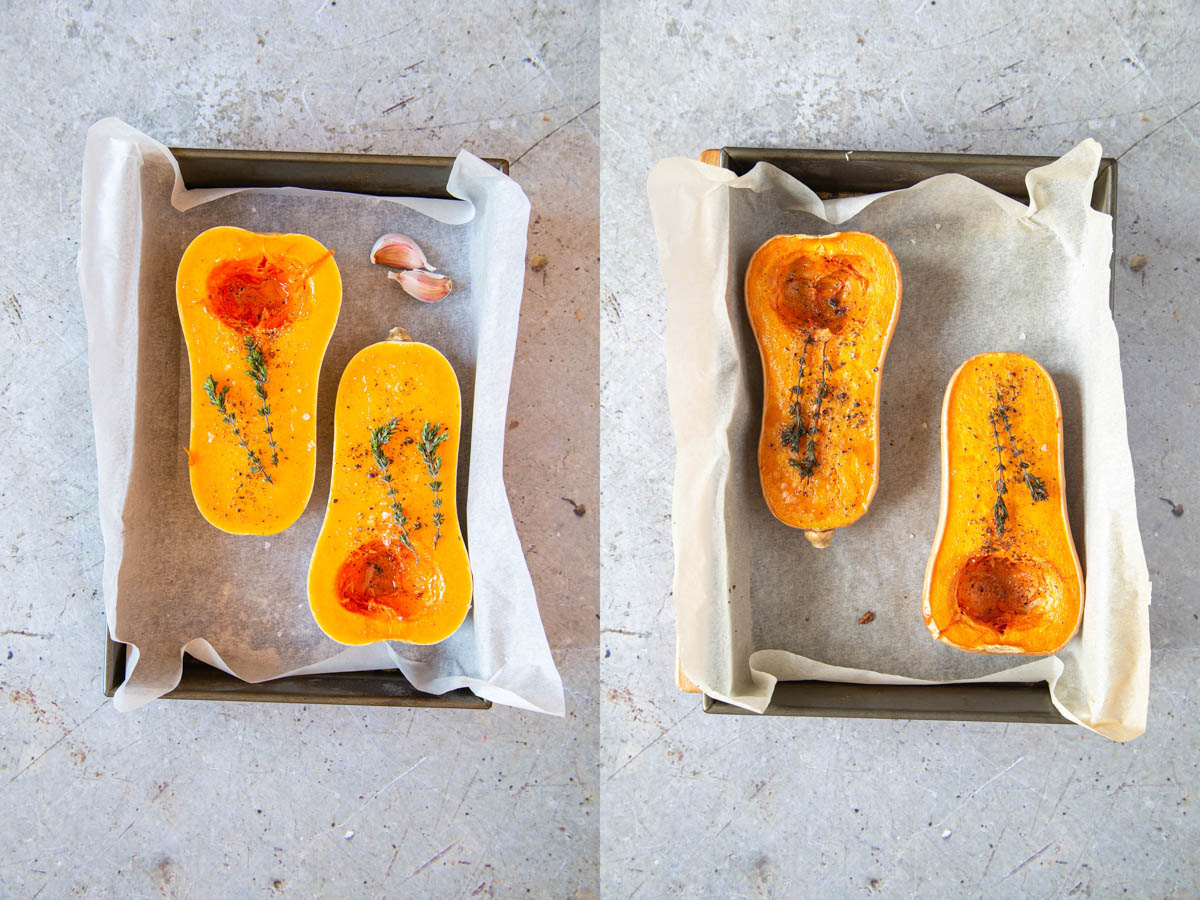
Step Two – Line a baking pan with some parchment paper. Then put the squash in, cut side up, drizzle over the olive oil, season with pepper and salt, and put a sprig of thyme on top of each half. Add the garlic to the pan (you don’t need to peel it).
Bake the squash for about 40 minutes until soft all the way through. Remove the garlic about half way through the cooking time, once it is soft.

Step Three – Discard the herbs, which will be charred. Scoop out the soft flesh, scraping it away from the skin. Put the flesh into a mixing bowl and let it sit for a good few minutes to steam dry.

Step Four – Add the butter, grated cheese. Squeeze the roasted garlic cloves out of the skin, into the bowl.
Blend the mash with a mixer, stick blender or in a food processor until silky smooth. Check the seasoning and adjust if necessary.
If needed, reheat in a pan or in the microwave.
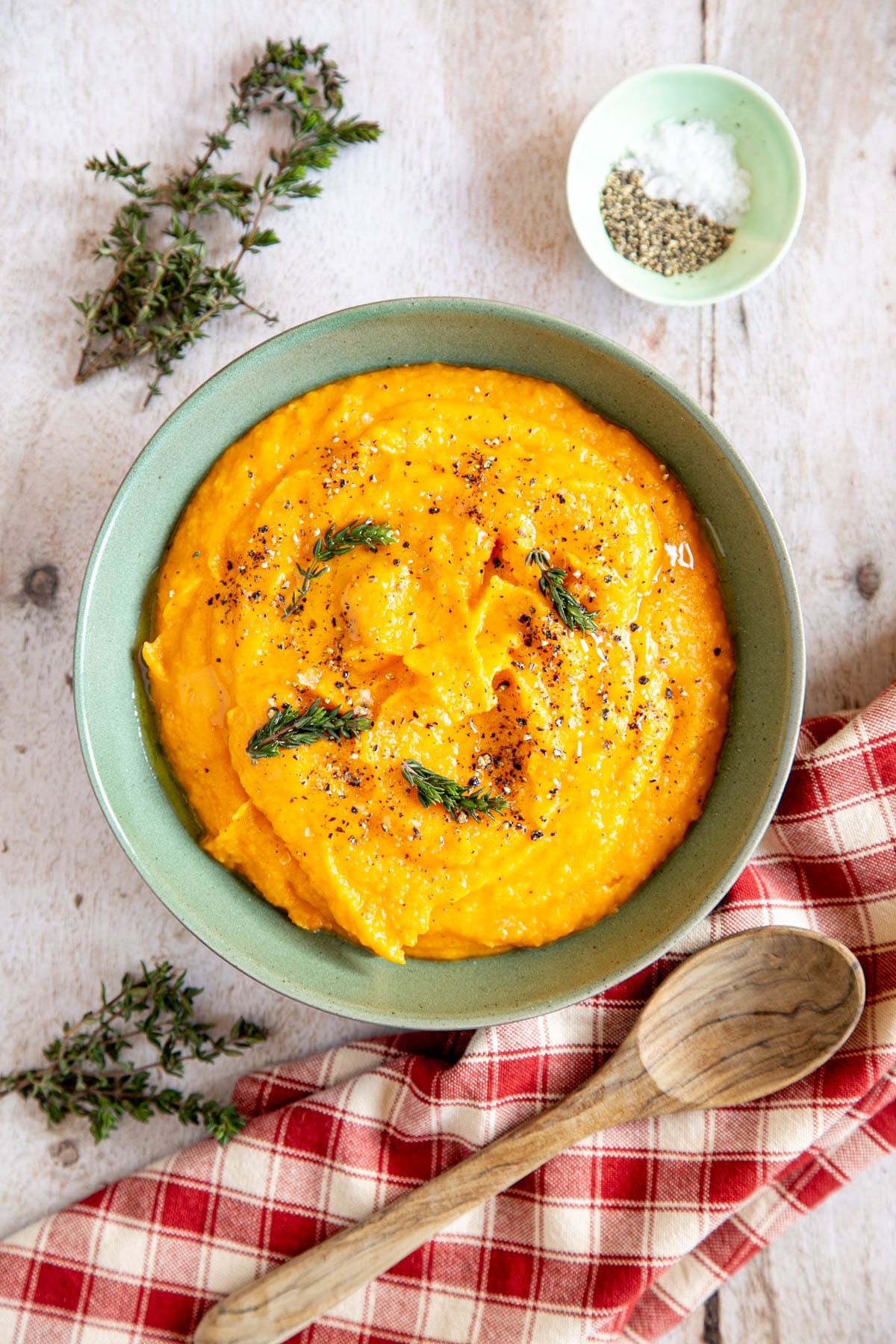
Step Five – Garnish with some fresh herbs and a knob of butter to serve.
How to serve mashed butternut squash
This mashed butternut squash recipe is delicious with stews and casseroles. Use it anywhere where you would usually serve mashed potato to soak up a sauce. We love it with my slow cooked beef casserole, sausage tray bake, or Spanish pork.
You can also use it as a topping for baked dishes such as shepherd’s pie and vegetable bakes.
Variations
- Try adding different herbs when you roast the squash – thyme, rosemary, oregano or a couple of bay leaves all work well.
- Sprinkle a spice blend over the squash when you roast it. ras el hanout, garam masala or similar would work well.
- Chop up and fry some bacon lardons until golden, and serve on top of the butternut squash mash.
- Make a mixed mash. Half butternut and half potato, or butternut and another roasted vegetable – sweet potato, swede, or carrots would all work well. You can mash them together or swirl two contrasting colours for a fancy effect when entertaining.
- Use dairy-free butter and cheese substitutes if you avoid milk.
Storage
Keep in the fridge in a covered container for up to three days, or freeze and defrost overnight in the fridge or leave on the counter top for a few hours.
You can then reheat in the microwave, in pan on the stove top, or in a covered oven dish.
Hints and Tips
- It is important to roast the squash, both to reduce the water content and to concentrate the flavour. Boiling or steaming will not work as well.
- If you are feeling lazy, you can buy bags of ready prepared chunks of butternut squash (either fresh or frozen).Roast as you would the halved squash.
FAQS
Diets are healthy or not, rather than individual foods! Butternut squash is packed with nutrition and makes a great addition to your diet. It’s full of vitamins and trace nutrients such as lutein (for eye health) and potassium. It counts as portion of vegetables if you are counting five a day, unlike potato mash.
Stand it in a fine mesh sieve and push some of the water out, reheat gently in a pan stirring all the time, or simply add some more grated cheese to thicken it.
Absolutely, you can make it earlier in the day or the day before. It’s easy to reheat in a pan on the hob or in the microwave.
Yes, it’s smooth, sweet and full of all the good things, though you will want to leave the salt and pepper out, go easy on the cheese and obviously don’t garnish it at the end.
Related Recipes / You may also love
- Roasted Butternut Squash – my complete guide on how to choose, prepare and roast butternut squash.
- Roast Butternut Squash Soup – the BEST butternut squash soup – made with roasted squash!
- Roast Swede – how to make the humble swede or rutabaga delicious- even if you don’t like swede you will love it roasted!
- Roasted Swede Soup – Roasting makes root vegetables delicious! This soup is a great winter warmer.
- Swede Chips (rutabaga fries) – sticky mustard swede chips make a delicious side.
More Easy Mash Recipes
Mash is so much more than potato – try these easy mash recipes!
- Swede Mash (Mashed Neeps) – a great alternative to potato mash – if you love this butternut mash give it a try.
- Celeriac Mash – Sweet and slightly nutty celery root mash is an excellent way to cook celery root.
Mashed Butternut Squash
Ingredients
- 1 butternut squash (600–800 g)
- 2 tbsp butter (30 g)
- 1 tbsp olive oil
- salt and pepper
Optional
- 1/3 cup Parmesan or other hard cheese (finely grated)
Instructions
- Preheat the oven on to 200°C / 400°F / Gas Mark 6.
- Cut the squash in half lengthwise and scoop the seeds out with a spoon.
- Line a baking pan with some parchment paper. Then put the squash in, cut side up, drizzle over the olive oil, season with pepper and salt, and put a sprig of thyme on top of each half. Add the garlic to the pan (you don't need to peel it).
- Bake the squash for about 40 minutes until soft all the way through. Remove the garlic about half way through the cooking time, once it is soft.
- Discard the herbs, which will be charred. Scoop out the soft flesh, scraping it away from the skin. Put the flesh into a mixing bowl and let it sit for a good few minutes to steam dry.
- Add the butter, grated cheese. Squeeze the roasted garlic cloves out of the skin, into the bowl.
- Blend the mash with a mixer, stick blender or in a food processor until silky smooth. Check the seasoning and adjust if necessary. If needed, boost the heat in a pan or in the microwave.
- Garnish with some fresh herbs and a knob of butter to serve.
Notes
- Keep in the fridge in a covered container for up to three days, or freeze and defrost overnight in the fridge or leave on the counter top for a few hours.
- You can then reheat in the microwave, in pan on the stove top, or in a covered oven dish.
- It is important to roast the squash, both to reduce the water content and to concentrate the flavour. Boiling or steaming will not work as well.
- If you are feeling lazy, you can buy bags of ready prepared chunks of butternut squash (either fresh or frozen).Roast as you would the halved squash.
- This recipe is 4 Weight Watchers points per portion

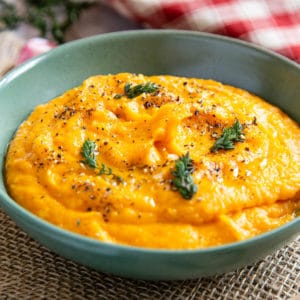


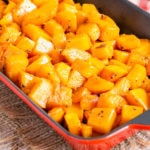

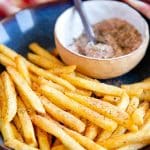
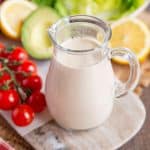
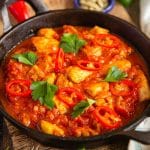





Halina
Fab recipe – really loved it and will be cooking again. Had with a simple baked cod and cabbage slaw with ginger dressing. A really tasty combination.